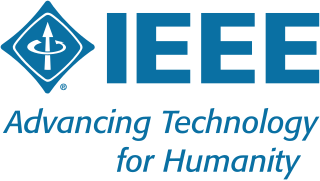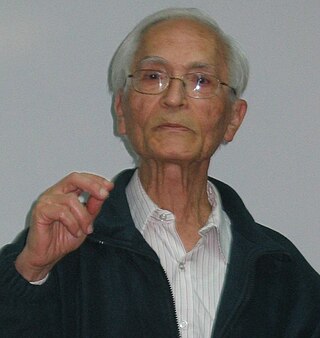Related Research Articles

Charles Proteus Steinmetz was an American mathematician and electrical engineer and professor at Union College. He fostered the development of alternating current that made possible the expansion of the electric power industry in the United States, formulating mathematical theories for engineers. He made ground-breaking discoveries in the understanding of hysteresis that enabled engineers to design better electromagnetic apparatus equipment, especially electric motors for use in industry.

The Institute of Electrical and Electronics Engineers (IEEE) is an American 501(c)(3) professional association for electronics engineering, electrical engineering, and other related disciplines.

Donald Oscar Pederson was an American professor of electrical engineering at the University of California, Berkeley, and one of the designers of SPICE, a simulator for integrated circuits that has been universally used as a teaching tool and in the everyday work of circuits engineers. The IEEE Donald O. Pederson Award in Solid-State Circuits is named in his honor.
Ronald W. Schafer is an American electrical engineer notable for his contributions to digital signal processing.
The American Institute of Electrical Engineers (AIEE) was a United States-based organization of electrical engineers that existed from 1884 through 1962. On January 1, 1963, it merged with the Institute of Radio Engineers (IRE) to form the Institute of Electrical and Electronics Engineers (IEEE).

The Thomas J. Watson Research Center is the headquarters for IBM Research. The center comprises three sites, with its main laboratory in Yorktown Heights, New York, U.S., 38 miles (61 km) north of New York City, New York and with facilities in Cambridge, Massachusetts and Albany, New York.

Jacob Ziv was an Israeli electrical engineer and information theorist who developed the LZ family of lossless data compression algorithms alongside Abraham Lempel.
Thomas Kailath is an Indian born American electrical engineer, information theorist, control engineer, entrepreneur and the Hitachi America Professor of Engineering emeritus at Stanford University. Professor Kailath has authored several books, including the well-known book Linear Systems, which ranks as one of the most referenced books in the field of linear systems.

Chandra Kumar Naranbhai Patel (born 2 July 1938) is an electrical engineer. He developed the carbon dioxide laser in 1963; it is now widely used in industry for cutting and engraving a wide range of materials like plastic and wood. Because the atmosphere is quite transparent to infrared light, CO2 lasers are also used for military rangefinding using LIDAR techniques.
Ernst Adolph Guillemin was an American electrical engineer and computer scientist at the Massachusetts Institute of Technology who spent his career extending the art and science of linear network analysis and synthesis. His nephew Victor Guillemin is a math professor at MIT, his nephew Robert Charles Guillemin was a sidewalk artist, his great-niece Karen Guillemin is a biology professor at the University of Oregon, and his granddaughter Mary Elizabeth Meyerand is a Medical Physics Professor at the University of Wisconsin-Madison.
Ronold Wyeth Percival King was an American applied physicist and electrical engineer, known for his contributions to the theory and application of microwave antennas. He published twelve books and over three hundred articles in his area, as well as mentored one hundred doctoral dissertations.
Ernst Weber, Austria-born American electrical engineer, was a pioneer in microwave technologies and played an important role in the history of the New York University Tandon School of Engineering, where in 1945 he founded the Microwave Research Institute. Weber was also the first president of the Institute of Electrical and Electronics Engineers (IEEE) and one of the founders of the U.S. National Academy of Engineering (NAE).
Emmett Finley Carter was an electrical engineer that worked at several companies; most notably, he was in upper management of Sylvania Electric Products and was the director, and later president, of SRI International from 1956 to 1963.
Robert H. Park was an American electrical engineer and inventor, best known for the Park's transformation, used for simplifying the analysis of three-phase electric circuits. His related 1929 concept paper ranked second, when looking at the impact of all twentieth century power engineering papers. Park was an IEEE Fellow and a member of the National Academy of Engineering.

Jeffrey H. Shapiro is a Julius A. Stratton Professor of electrical engineering and computer science at the Massachusetts Institute of Technology and the former director of the Research Laboratory of Electronics. He made seminal contributions to understanding the fundamental quantum limits on communications, generation, detection, and application of quantum squeezed state, ghost imaging, and quantum information science. He invented the microchannel-plate spatial light modulator with Cardinal Warde.
James Beverly Owens was an American engineer and company executive.
Mangalore Anantha Pai was an Indian electrical engineer, academic and a Professor Emeritus at the University of Illinois at Urbana–Champaign. A former professor of electrical engineering at the Indian Institute of Technology, Kanpur, he is known for his contributions in the fields of power stability, power grids, large scale power system analysis, system security and optimal control of nuclear reactors and he has published 8 books and several articles. Pai is the first India born scientist to be awarded a PhD in Electrical Engineering from the University of California, Berkeley.
Ranjan Kumar Mallik is an Indian electrical and communications engineer and a professor at the Department of Electrical Engineering of the Indian Institute of Technology, Delhi. He held the Jai Gupta Chair at IIT Delhi from 2007 to 2012 and the Brigadier Bhopinder Singh Chair from 2012 to 2017. He is known for his researches on multiple-input multi-output systems and is an elected fellow of all the three major Indian science academies viz. Indian Academy of Sciences, Indian National Science Academy, and The National Academy of Sciences, India. He is also an elected fellow of The World Academy of Sciences, Indian National Academy of Engineering, and The Institute of Electrical and Electronics Engineers, Inc.
Yendluri Shanthi Pavan is an Indian electrical engineer and a professor at the Department of Electrical Engineering of the Indian Institute of Technology, Madras. He is known for his studies on mixed signal VLSI circuits and is an elected fellow of the Indian National Academy of Engineering. He is also a fellow of IEEE. The Council of Scientific and Industrial Research, the apex agency of the Government of India for scientific research, awarded him the Shanti Swarup Bhatnagar Prize for Science and Technology, one of the highest Indian science awards for his contributions to Engineering Sciences in 2012.
Mark Jeffrey Rosker is a physicist at the Defense Advanced Research Projects Agency (DARPA) in Arlington, Virginia. He was named a Fellow of the Institute of Electrical and Electronics Engineers (IEEE) in 2012 for his work on microwave and millimeter-wave phased arrays, gallium nitride semiconductors, and terahertz electronics.
References
- ↑ "The Institute" (PDF). IEEE. Retrieved December 31, 2019.
- ↑ "Jeffrey O. Kephart" (PDF). Grand Challenge Statements Submitted. Computer Research Association. Retrieved 13 June 2022.